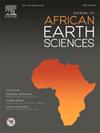Hydrogeochemical properties of Çal Cave and its vicinity: Development and consequences of karstification in Düzköy (Trabzon, NE Türkiye)
IF 2.2
4区 地球科学
Q2 GEOSCIENCES, MULTIDISCIPLINARY
引用次数: 0
Abstract
Çal Cave, through which an underground river runs, was formed through the karstification of the neritic limestones that make up the Şahinkaya Formation, located between the neighbouring districts of Çayırbağı and Çalköy in Düzköy (Trabzon). The purpose of this study was to analyse the hydrogeochemical characteristics of samples collected from Çal Cave and the waters believed to supply it to determine their potential origins. Water samples were collected from nine locations during the wet and dry periods. After measuring the physical parameters of the samples, major anion–cation and trace element analyses were performed. When the parameters were compared with both WHO and Turkish standards, it was determined that they were within the limit values specified in the relevant regulations. Schoeller and Piper diagrams suggest that these waters are fed by the same origin and can be classified as a Ca-HCO3 water type. Water-saturated zones were identified through electrical resistivity tomography sections that analysed the areas around the sampling sites. Finally, a comparison of the water quality data of water samples from Çal Cave during the dry season, published by Ofluoğlu in 1993, and this study's dry season water quality data revealed a decrease in the concentrations of Ca2+, Mg2+, K+, Cl− and SO42−. The reason for this decrease over the past 29 years is likely the increased number of entryways where surface waters feed the cave.
Çal洞穴及其邻近地区的水文地球化学特征:Düzköy (Trabzon, NE trkiye)岩溶作用的发育及其后果
Çal洞穴,一条地下河流经其中,是由组成Şahinkaya组的浅海石灰岩的岩溶作用形成的,位于Düzköy (Trabzon)的Çayırbağı和Çalköy邻近地区之间。本研究的目的是分析从Çal洞穴收集的样品和据信为其提供的水的水文地球化学特征,以确定它们的潜在来源。在湿润期和干燥期从9个地点采集水样。测定样品的物理参数后,进行了主要阴离子、阳离子和微量元素分析。将这些参数与卫生组织和土耳其的标准进行比较后,确定它们在有关条例规定的极限值之内。Schoeller图和Piper图表明这些水来自同一来源,可归类为Ca-HCO3水类型。通过分析采样点周围区域的电阻率断层扫描剖面,确定了饱和水区。最后,将Ofluoğlu于1993年发表的Çal洞窟枯季水样水质数据与本研究的枯季水质数据进行比较,发现Ca2+、Mg2+、K+、Cl−和SO42−浓度降低。在过去的29年里,这种减少的原因可能是地表水喂养洞穴的入口数量增加了。
本文章由计算机程序翻译,如有差异,请以英文原文为准。
求助全文
约1分钟内获得全文
求助全文
来源期刊

Journal of African Earth Sciences
地学-地球科学综合
CiteScore
4.70
自引率
4.30%
发文量
240
审稿时长
12 months
期刊介绍:
The Journal of African Earth Sciences sees itself as the prime geological journal for all aspects of the Earth Sciences about the African plate. Papers dealing with peripheral areas are welcome if they demonstrate a tight link with Africa.
The Journal publishes high quality, peer-reviewed scientific papers. It is devoted primarily to research papers but short communications relating to new developments of broad interest, reviews and book reviews will also be considered. Papers must have international appeal and should present work of more regional than local significance and dealing with well identified and justified scientific questions. Specialised technical papers, analytical or exploration reports must be avoided. Papers on applied geology should preferably be linked to such core disciplines and must be addressed to a more general geoscientific audience.
 求助内容:
求助内容: 应助结果提醒方式:
应助结果提醒方式:


